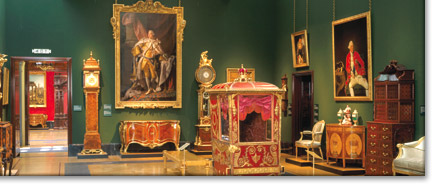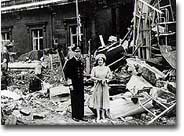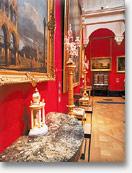Queen's Gallery - a Brief History

The Queen's Gallery at Buckingham Palace is a permanent space dedicated to changing exhibitions of items from the Royal Collection, the wide-ranging collection of art and treasures held in trust by The Queen for the Nation. Constructed forty years ago on the west front of Buckingham Palace out of the bomb-damaged ruins of the former private chapel, the Gallery has recently been redeveloped. It was reopened by The Queen on 21 May 2002 and is now open to the public on a daily basis.

The original Queen's Gallery was constructed out of the ruins of the former private chapel (on the west front of Buckingham Palace), which had been gutted by a German bomb on 13 September 1940.
The original building was designed by John Nash as one of the Palace's three identical conservatories or pavilions in the form of Ionic temples. It was constructed on the south-west corner of the Palace, facing the garden, and was completed in 1831. The building was converted into a private chapel for Queen Victoria in 1843 but destroyed in an air raid in 1940.
At the suggestion of The Queen and The Duke of Edinburgh, it was redeveloped as a gallery for the Royal Collection in 1962. The Queen's Gallery was planned as a small exhibition space open to the public in which changing exhibitions could be mounted to display works of art from all sections of the Royal Collection.
The Gallery was opened to the public on 25 July 1962. In the following decades a succession of exhibitions was mounted, each lasting between a year and eighteen months. The first was a miscellany of items, entitled Treasures from the Royal Collection. Other exhibitions included displays of works by Leonardo (1969-70), Van Dyck (1968), Canaletto (1980-81); photographs from the Royal Photograph Collection; postage stamps from the Royal Philatelic Collection; and Faberge items.
 The expansion of The Queen's Gallery is the most significant addition to Buckingham Palace in 150 years. The 20 million GBP project has been funded entirely by the Royal Collection Trust.
The expansion of The Queen's Gallery is the most significant addition to Buckingham Palace in 150 years. The 20 million GBP project has been funded entirely by the Royal Collection Trust.
In 1997 a limited competition was held for the appointment of an architect to expand and modernise the existing Gallery. The opportunity was also taken to refurbish the Victorian kitchens below.
The Gallery brief was to upgrade the outdated air-conditioning, to improve physical access and public services, and to provide a more flexible and intelligible series of exhibition spaces. John Simpson & Partners were appointed project architects in 1998.
In adding new galleries and associated spaces, John Simpson has had to work within the complexities of an existing building, as remodelled after Nash's time by Blore, Pennethorne and Webb.
Each architect continued the strong classical language of Buckingham Palace, and Simpson has chosen to respond to this in an imaginative and sympathetic manner.
Particular challenges were to provide a bold new entrance to the Gallery and to resolve the awkward external junction between the Victorian buildings and the 1980s police accommodation above the old shop.
A new screen wall has been created between the Gallery's entrance hall and display areas, which replicates the original wall of Pennethorne's scheme and completes the Palace's garden facade.
Containing three-and-a-half times more display space, the new Queen's Gallery is approached through a striking portico leading to a soaring double-height entrance hall and staircase. A multimedia room provides space for computer kiosks, which can be used independently of a visit to the exhibitions. They provide information about items in the current display.
On the upper level of The Queen's Gallery there are seven galleries or rooms, used in a variety of combinations, for special exhibitions of paintings, prints, drawings and watercolours, furniture, porcelain, miniatures, enamels, jewellery and other works of art. The new public areas on the first floor include education and lecture rooms for a range of events.